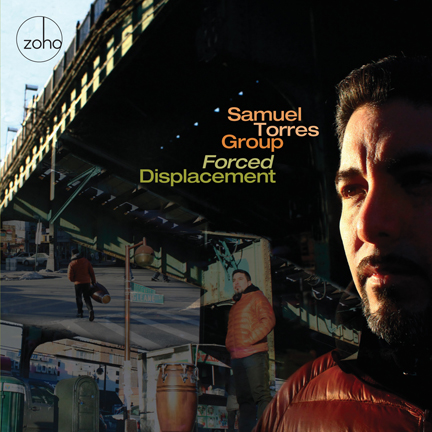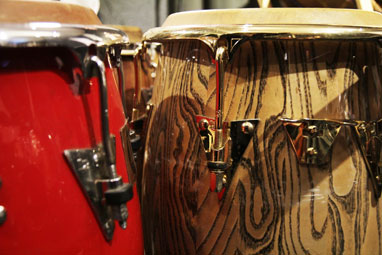|
|
Samuel Torres Group
Forced Displacement
Release Date: July 10, 2015
Selection #: ZM 201507
UPC Code: 880956150727
Availability: Worldwide
Songs:
1. Overture 2:20
2. Las Canta’oras (The Female Singers) 7:42
3. Velada de Tambores (Drums Soiree) 2:18
4. Narrador de Espejismos (Narrator of Mirages) 6:44
5. Niño Pensante (The Thinking Child) 3:35
6. El Silencio Desplazador (Displacing Silence) 7:04
7. Lluvia, Luna y Voz (Rain, Moon and Voice) 1:18
8. Emilsen, El Hijo de San Juan (Emilsen The Son of San Juan) 6:42
9. El Orgullo del Tambor (Drum’s Pride) 6:12
10. Finale 6:04
|
Musicians:
Samuel Torres - Congas
Michael Rodriguez - Trumpet and Flugelhorn
Yosvany Terry - Alto and Soprano Saxophones
Marshall Gilkes - Trombone
Luis Perdomo - Piano
Ricky Rodriguez - Acoustic Bass
Obed Calvaire - Drums
Jonathan Gómez - Colombian Percussion : Tambor Alegre, Tambora Costeña, Maracón, Tambor Llamador, Calabaza
Samuel Torres, Marshall Gilkes, Obed Calvaire, Edmar Castañeda - Claps
|
 |
|
When Colombian-born percussionist-composer and New York area resident Samuel Torres was awarded a New Jazz Works Grant by Chamber Music America in 2012, he knew he wanted to create something important, something that would resonate with a depth of meaning that went beyond notes on the page. As he explained, “I wanted it to have a special theme, not just music that I enjoy but something with a social element, which is something I have never done before.”
What Torres came up with is a profoundly deep 10-movement suite of music that addresses a tragic issue occurring in his beloved native country. “I decided to write a piece dedicated to the victims of violence in Colombia caused by the ongoing conflict between guerrillas, paramilitary groups, and the national army, especially the Afro-Colombian community that is usually in the most afflicted areas of violence in the country.”
Inspired by a visit to rural San Juan de Urabá , and particularly his encounter with Afro-Colombian folkloric master Emilsen Pacheco, Forced Displacement is a stirring paean to his fellow countrymen. A powerful suite based on bullerengue, a traditional Colombia form of music whose roots can be traced back to Africa in the call-and-response refrains that are the essence of this mesmerizing music, Forced Displacement boasts an all-star ensemble of eight top-notch musicians now living in New York -- Venezuelan pianist Luis Perdomo, Cuban saxophonist Yosvany Terry, Colombian percussionist Jonathan Gómez, trumpeter Michael Rodriguez, trombonist Marshall Gilkes, bassist Ricky Rodriguez and drummer Obed Calvaire. For this career-defining work, Torres draws on his classical training and mixes in jazz harmonies and improvisation while retaining the folkloric foundation for a stimulating and thought-provoking statement.
“Of course, this is a very strong subject,” says Torres. “Most people are afraid to talk about it, because they are scared about the repercussions, but Emilsen told me his stories. So all the titles of the pieces have to do with something that he said about his life in San Juan de Urabá -- the way that he saw the problems in Colombia, the displacement, the displacing silence...those are all his phrases.”
The suite opens in melancholic fashion with a dark minor key Overture introducing a simple motif that reappears throughout the suite. From there, Torres and his crew segue to the lively Las Canta’oras (The Female Singers), inspired by the great bullerengue singers Etelvina Maldonado and Petrona Martinez. Marshall Gilkes delivers a lovely trombone solo and is followed in succession by Yosvany Terry and Michael Rodriguez, each of whom turns in stellar solos on this invigorating number.
Velada de Tambores (Drums Soiree) opens with a solo statement tambor alegre (happy drum) played by Jonathan Gomez before the horns enter in intricate fugue-like fashion. “The idea of doing that intricate thing with the horns is actually very normal in the traditional musics from the Caribbean coast,” says Torres. “It’s like New Orleans brass bands, involving a lot of counterpoint. I thought it was really interesting to change the roles of the instruments, where the horns keep the rhythm and then the percussion plays the melodic part.”
Narrador de Espejismos (Narrator of Mirages) addresses the victims of displacement and their clever survival skills of speaking in code to evade punishment by the criminal organizations. As Torres explained, “One of the first things that Emilsen said when I talked to him was, ‘When you say the truth in this town, they will kill you. So I just say lies.’ And when I asked what he meant, he said, ‘I have to disguise my messages in metaphors, in poems. Because if you say things denouncing anything, they will kill you. If you fight for the union, if you fight for human rights, they kill you. So you have to give your message in code. And people who hear me might think I say crazy things, but my message goes to the people who understand my code and know what I’m trying to say. So it’s like making mirages.” In keeping with that idea of disguising intent, Torres masterfully displaces 4/4 with accents until a new rhythmic feel is formed...like a mirage.
|
 Niño Pensante (Thinking Child) opens with a funereal drum cadence before the full ensemble enters at the 1:20 mark. The melancholy feel continues throughout this piece. As Torres explains, “Though Emilsen is a guy with no formal education, he’s very intelligent. And when I asked about his childhood, he said, ‘I was playing and everything, like most children, but I was also thinking a lot. I was always thinking about things and how people do things.’ He’s such a wise man, like a master of life.” Niño Pensante (Thinking Child) opens with a funereal drum cadence before the full ensemble enters at the 1:20 mark. The melancholy feel continues throughout this piece. As Torres explains, “Though Emilsen is a guy with no formal education, he’s very intelligent. And when I asked about his childhood, he said, ‘I was playing and everything, like most children, but I was also thinking a lot. I was always thinking about things and how people do things.’ He’s such a wise man, like a master of life.”
El Silencio Desplazador (The Displacing Silence) is another dark, minor key piece that unfolds patiently while recycling the motif introduced in the opening track. Says Torres of the underlying meaning of this tune: “Emilsen told me, ‘We black people are noisy, we play drums, we play our music loud. And in our community, that’s an invitation. It’s not to bother my neighbor, it’s to invite my neighbor to my house and share with him.’ And he also said, ‘When the intruders came here, the first thing they do is to silence us so that now you cannot sing, now you cannot play music loud. And that’s how the community began to get displaced and disbursed....through silence.’ So in this piece, the silence becomes an element in the composition. That’s why at the beginning it doesn’t have any drums. And there’s a point where there’s only the piano and I intentionally left one bar of complete silence where you could like hear the silence. That’s like making the silence an actor of this movie.”
Lluvia, Luna y Voz (Rain, Moon and Voice) was inspired by one night with filmmaker Noelia Santos. As Torres recalls, “She came to San Juan de Urabá to make a documentary about Forced Displacement, and one night there was a storm. We had to walk about 20 minutes back to our place and, of course, got drenched. Along the way we ran into Emilsen. It was completely dark in this jungle area close to the sea, it was raining, the moon was shining and then Emilsen began to sing an improvised bullerengue. And that’s when I thought, ‘Wow! It’s truly part of his life. It’s how he expresses himself, how he lives. I understand finally how it is. This is the special moment!’”
Emilsen, El Hijo de San Juan (Emilsen, the Son of San Juan) is Torres’ dedication to Pacheco. “That’s a piece I dedicated to him to thank him for everything,” he says. “Because he said that his main dream is that one day people will recognize what he has done for his community and for folklore.”
The driving El Orgullo del Tambor (The Drum’s Pride) is a number teeming with polyrhythms that also features potent solos from trombonist Gilkes and trumpeter Rodriguez and culminates in a dynamic percussion jam at the tag. And the dramatic Finale is a passionate five-minute solo showcase by Torres before the full ensemble enters for the final minute to reprise the theme.
Torres’ third recording as a leader, which organically and brilliantly integrates roots music with a Latin jazz ensemble sound, stands as his masterwork.
-- Bill Milkowski
Produced by Samuel Torres. Recorded by Todd Whitelock on February 6, 2014 at Sear Sound, New York City. Mixed and mastered by Todd Whitelock at Flux Studios, New York City. Photography by Lara Bello and Noelia Santos. Art direction and package design by Jack Frisch. Executive Producer: Joachim "Jochen" Becker.
|
|
|
|

